By Christina Newhard
Designer, writer, cat servant. Founder of Sari-Sari Storybooks. Filipina American. I hail from Manila, Florida, NYC, and Oakland, in that order. she/her
Before you read this, a request: take some time, before forwarding or reacting to it. Please don’t share your “hot take” on social media — that’s not helping. Call a friend or journal about it, and think of what’s actually needed here, what you might offer.
This story is hard to write, given the pain in the Filipino/a/x community right now. I’m acutely aware of stepping into a field of landmines. I’m afraid of being flamed online or my privacy violated, or offending my community. I will try my best to write with empathy for everyone involved, from my lived experience as mixed race Fil-Am, a cis woman, and a Philippine content creator. That’s hard when we’re all carrying a lot right now, but I am going to try. Be kind to me, and everyone involved.
Our communities deserve better than one more unprocessed trauma, lingering like the ghost of a car crash, because people are afraid to say anything, and we don’t have the information we need to move past it. I want to share that missing information, so people can process it.
What the Heck Happened?
About six years ago, I was writing a children’s book about the friendship between a little girl and a little monster from Philippine folklore, “Kalipay and the Tiniest Tiktik.” It’s a story about friendship and bullying, social exclusion and self-sacrifice. At its heart? It’s about how kapwa can create happiness for everyone.
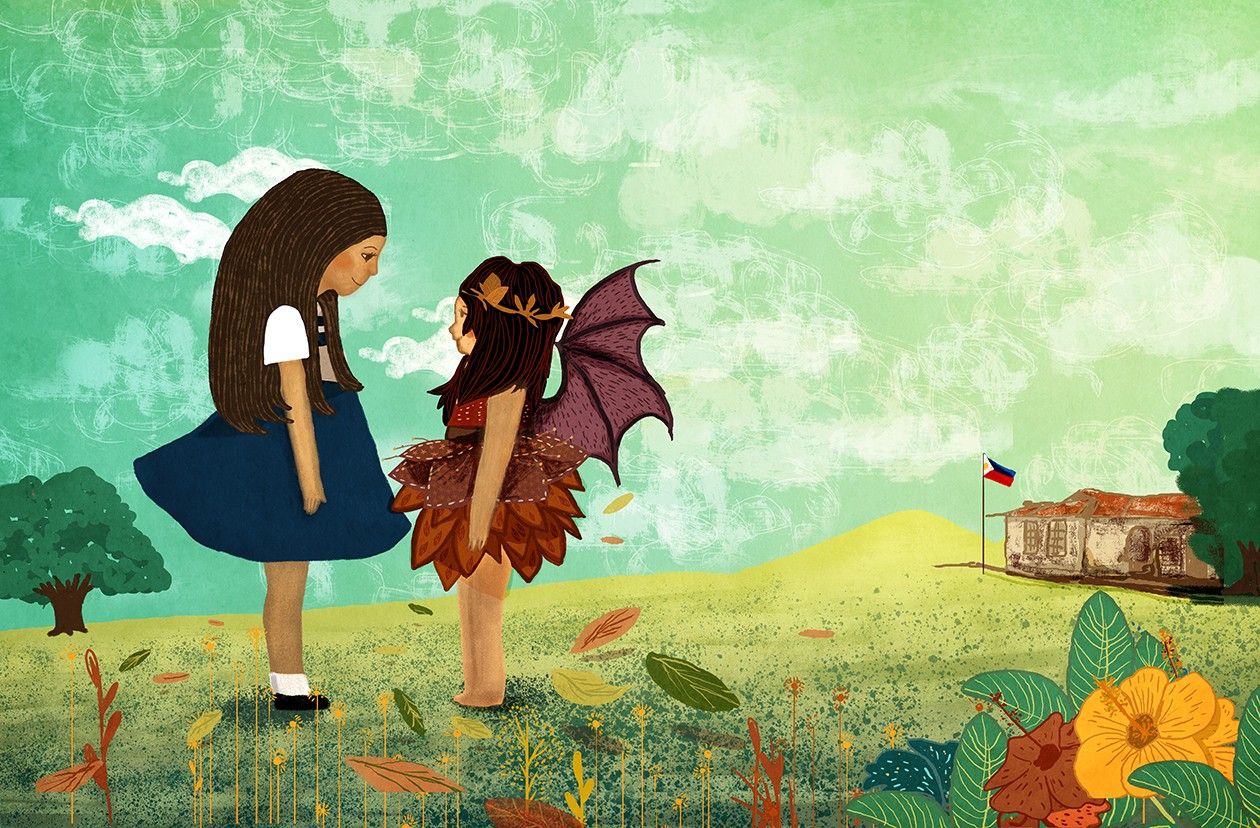
While researching the manananggal (the tiktik is the Visayan variant in my story), I emailed The Aswang Project, a popular online resource about Philippine mythology. As the whole of the Filipino interwebs are probably sick of hearing by now, its founder, Jordan Clark, is white. Specifically, white Canadian, married to a Filipina-Canadian. They have a daughter and live in Canada.
He began with a documentary called “The Aswang Phenomenon” that was published online in 2011. It featured interviews with or leans on source material given by Philippine mythology experts like Peque Gallaga, Budjette Tan, and Gilda Cordero-Fernando. It is a useful resource for students of mythology, since it’s available online for free. Mythology books can be expensive and hard to track down, so this and the website were significant — they filled a need, especially for university students in the Philippines. The website has since grown steadily and reached bigger and bigger audiences beyond the Philippines, especially among diaspora Filipino/a/x/s seeking to connect to their roots.
By chance, we both passed through Manila at the same time for project research, and met up to talk about mythology at a coffeeshop. Jordan came across as sincere, a little reserved, and a total geek. The kind that loves the work but hates the spotlight. He can talk for a very, very long time about Philippine mythology. He offered to promote my book on his site and platforms, possibly interview me and my illustrators when it was done. He was kind to me, an unknown with no publishing experience or funding, with an impractical but earnest desire to start my own Filipino children’s book press.
In other words — he just wanted to see me succeed. Some people are like that.
Knowing his wife was Filipina Canadian and a mom, I asked if I could interview her by email. I had a questionnaire to assess attitudes towards my book with diaspora Filipino parents. Jordan put me in touch with her (Interview excerpted here. Any identifying info is blocked out, to protect her privacy.)
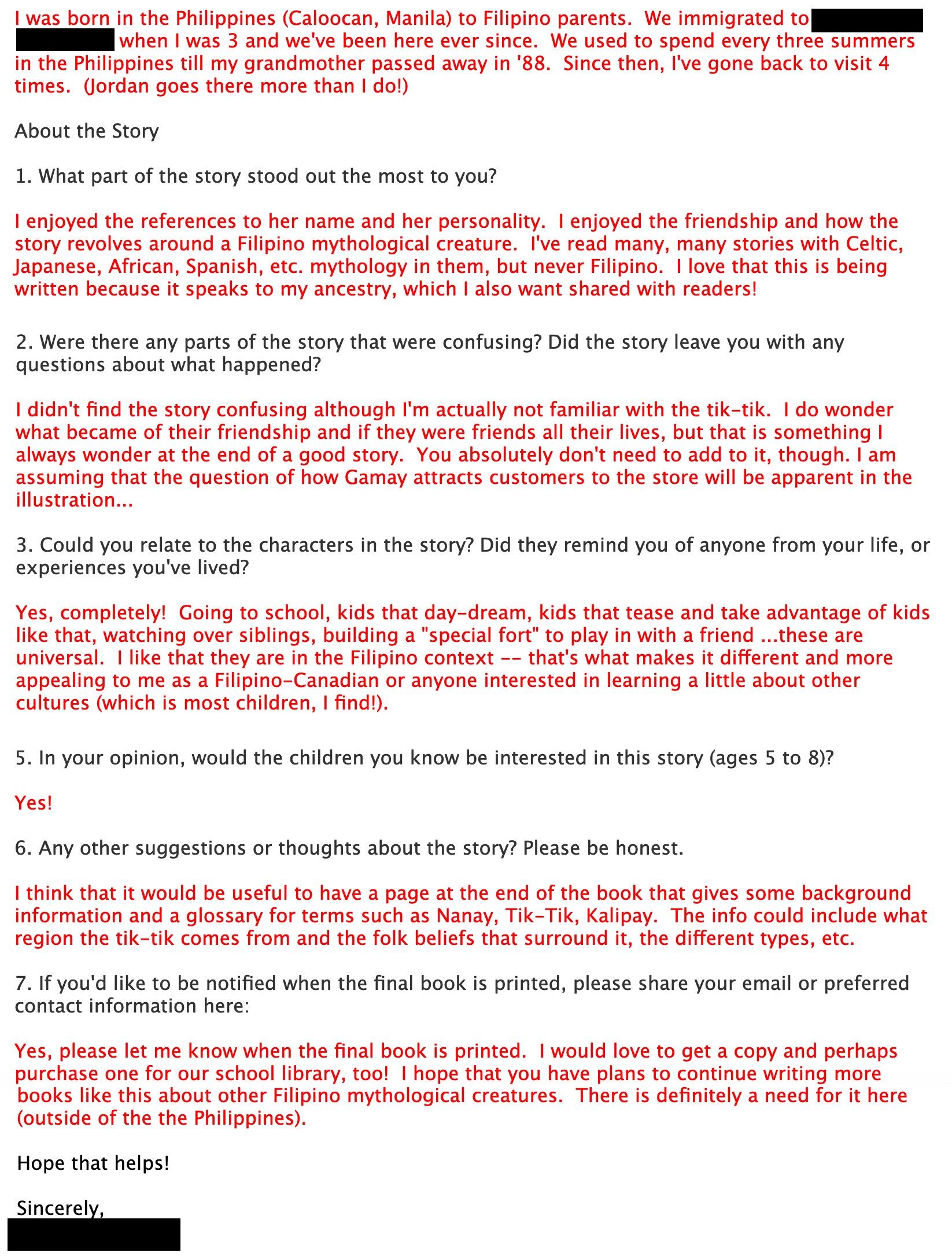
Jordan boosted my 2016 Kickstarter on his platforms to help me with funding. I published “Kalipay” and two other titles in 2017 with the launch of my press, Sari-Sari Storybooks.
Fast forward to the present… Two weeks ago, a controversy erupted online about The Aswang Project, on social media. Specifically, about Jordan’s race, that he was a white man running a Philippine content site. It was (mostly) common knowledge in the Philippines, especially in the mythology community, who had either met him, collaborated with him through email, seen him/heard his voiceover in the documentary and could tell the speaker was white, or in researching him had assumed “Canadian” in his website bio to mean white.
For a chunk of the newer audience (many of them Fil-Ams coming to TAP through Instagram) many didn’t know his race. His personal bio isn’t on TAP’s Instagram. The documentary with the white-sounding narrator who also appears on camera was not their entry point. They assumed “Canadian” meant “Filipino Canadian” in this context — a Philippine mythology site author. His bio image is an illustration, not a photo. Jordan is a private person by nature, and there are barely any photos of him online when you look.
For more context on how technology contributed to this divide — audiences across TAP’s platforms are very different. 60% of TAP’s Instagram audience comes from Los Angeles. It is not just heavily Fil-Am, but primarily California Fil-Am. 80% of TAP’s Facebook audience, on the other hand, comes from the Phiilppines.
TAP’s socials started getting rapid spam — posts demanding that Jordan tell people he’s white. Jordan responded by updating his bio to include his race, his family, and more specifics about TAP. He then posted a public apology acknowledging the issue and hurt, and offered a list of Filipino/a/x creators to follow instead of TAP.
Instead of calming down, the anger swelled. He was our own Rachel Dolezal. He was profiting off our culture like a colonizer. There was especial anger that he mentioned a “Filipino wife” in the apology. That he was using her to “get out of this.”
I read that and thought, “umm, it’s not weird to mention your wife is Filipina in this context? Don’t make it weird.”
And then, things blew up.
An author whose book he had promoted on TAP published a statement accusing Jordan of racially deceiving her. She was angry to learn that the man on the other side of that friendly correspondence was not Filipino Canadian, but white Canadian. That in their long exchange, he never brought up his race. She screenshot a before & after of the bio he had just updated on his site, and said it was evidence of him trying to trick people. It was important to her, on her debut book of mythology-infused essays that she had worked on for years, that she was collaborating with a fellow Filipino. She felt creeped out, and she shared their entire messenger conversation online. To put it this way — it was a core value for her that the promotion had been with a fellow Filipino, and she had not consented to this situation.
A graphic artist, a good friend of the author, had been organizing with several others to publicly stand with the author and amplify her statements on Instagram, denouncing Jordan and The Aswang Project. The artist, along with many others in their Instagram circle, had also recently learned that TAP’s founder is white, not Filipino, and had similar feelings of being duped.
I saw community, some of my own friends, liking and sharing the posts. When I first saw this happening, I was in disbelief. But there was also a nagging thought — if I had no previous knowledge of the situation myself but this groundswell of anger and condemnation, specifically female and queer anger, on Instagram, wouldn’t I also like these posts and express solidarity? The story sounds so painfully familiar.
I live in this world as a woman. I know that rage. Not being believed when men do shitty things to women. I have worked on the communications team for a survivors advocacy organization, led by women of color, and wow, the hate mail. I’m a survivor of sexual assault myself, and one of the questions I was asked when I filed a police report was “do you have any mental issues?” There were male bystanders who saw me yelling and running after the man who attacked me, only to lose interest when they realized he had not robbed me, only assaulted me. What brought me comfort was how my circle responded — they did nothing but offer support, share their own difficult stories, remind me it wasn’t my fault, that I was far from the only one this happened to.
So that’s all to say: I understand the impulse to support the author and her friends. Those feelings aren’t wrong. Sexism and transphobia go unchallenged in our communities and world at large. The barest linguistic recognition of trans and genderqueer people, the term “Filipinx,” a way to signal “you’re safe with me” to our queer community, triggers deep online hostility.
What I don’t understand, though? I don’t understand what came next.

Bizarre and ugly posts appeared on the author’s Instagram (they have since been deleted). They claimed that … Jordan did not exist. They claimed his wife and child were fake, he was a white supremacist in disguise with multiple fake accounts and was now cyberstalking the author via email. They demanded that Jordan produce a photo of himself, with “OUR” community, to prove his existence.
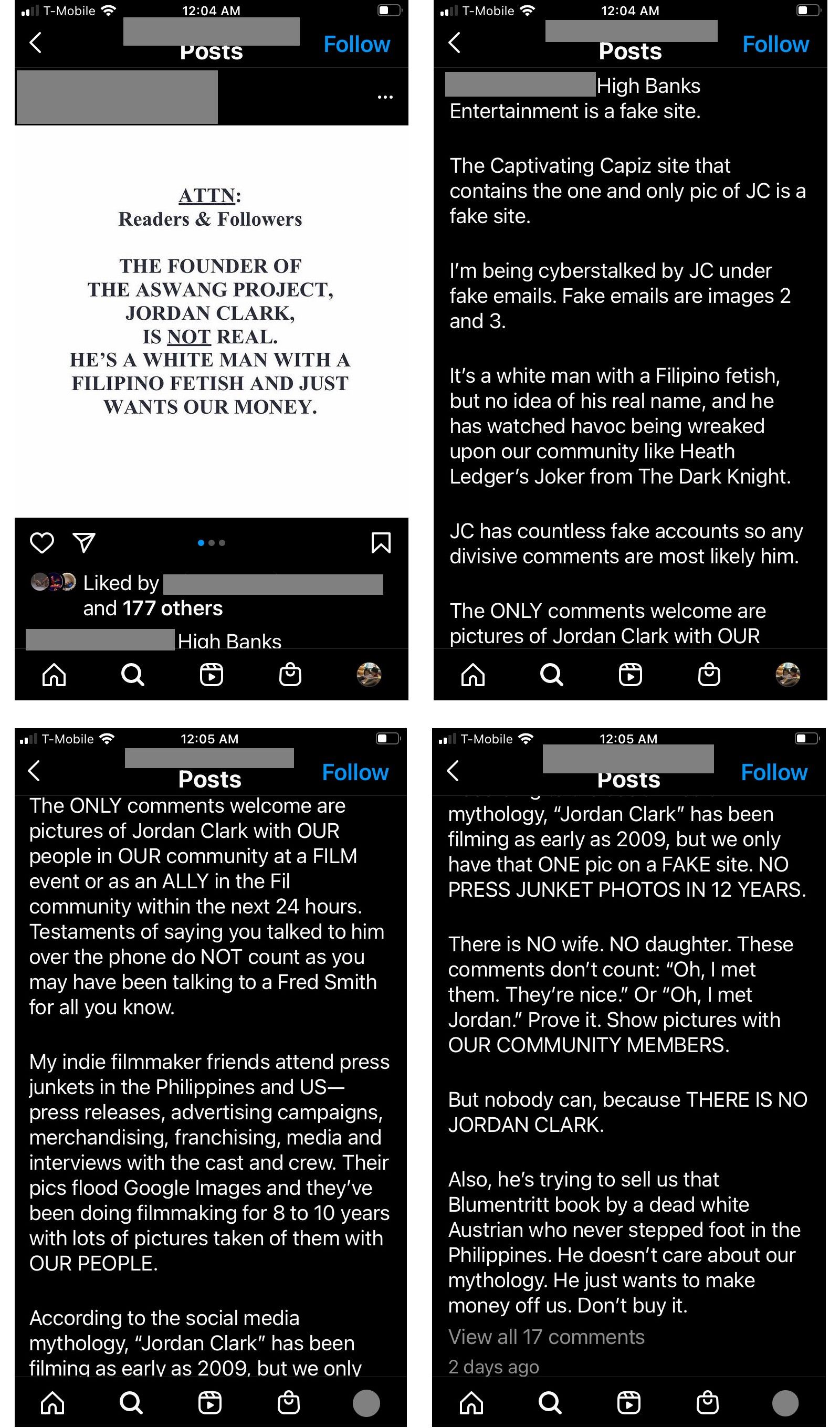
This is one of several posts like this over 3 days. An escalating demand for Jordan to produce photos of himself. At the end, the author, the graphic artist, and their supporters began harassing Philippine culture / community Instagram accounts that Aswang Project had recommended, accusing them of being Jordan Clark in disguise and demanding the account admins show their faces. They pressured two accounts into producing photos.
Here’s one exchange. The speakers are color-coded — burgundy is the IG account holder, grey is the author.

And another. Account holder is red, grey is author, mustard is the graphic artist tag-teaming with author in pressuring account holder to show himself. The IG account holder finally showed his face on his IG stories, though clearly he didn’t want to:
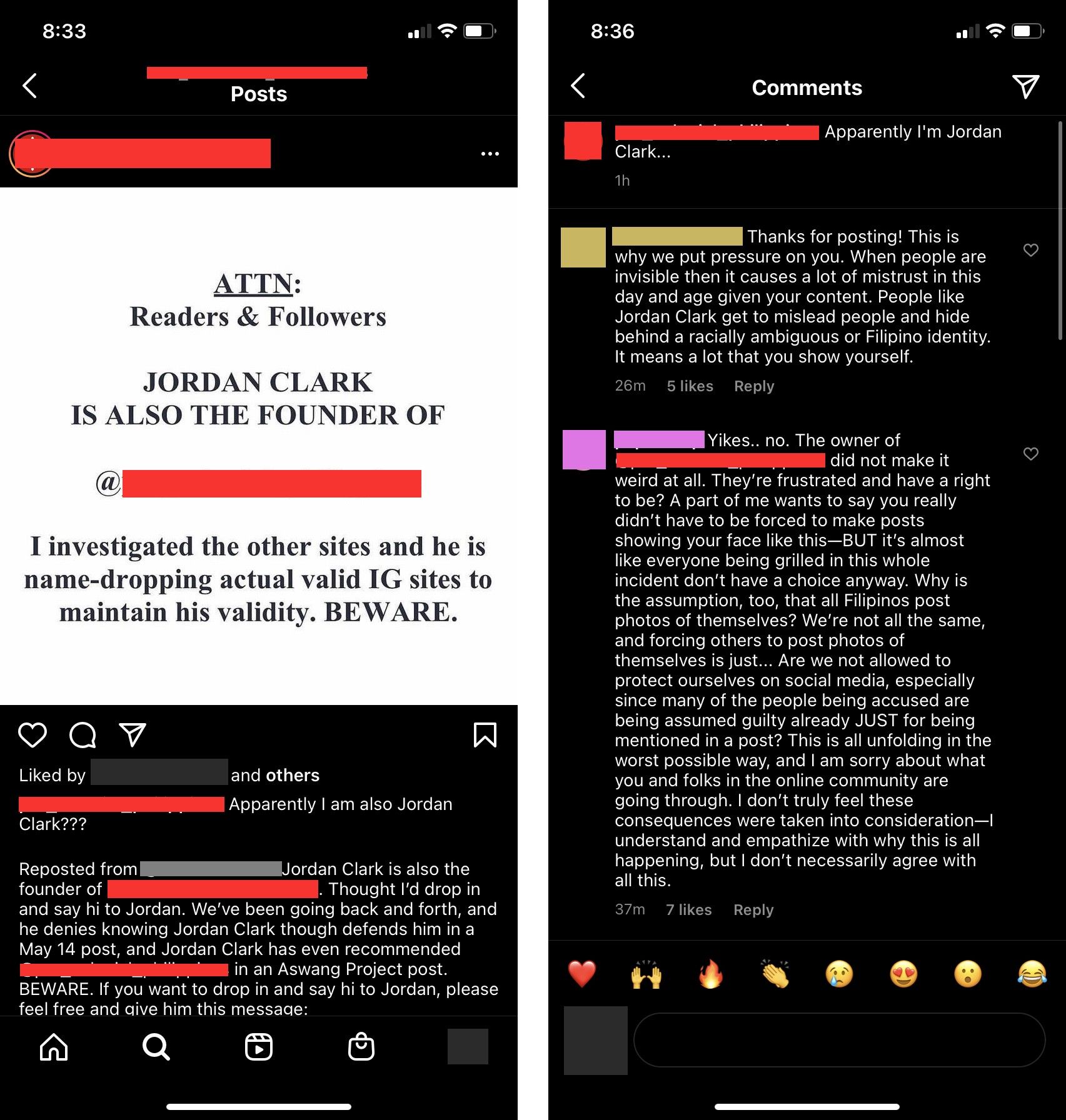
There are more of these disturbing posts, but you get the idea. They targeted not just Jordan, but Filipino content sites mentioned by The Aswang Project (and I must note that trying to isolate your target is an abuse tactic).
Watching someone bully others into showing their faces disturbed me deeply. There are very good reasons to keep your data and face offline, not least of which is the Philippines’ Anti-Terrorism Act of 2020. The demand for photos, in general, the idea that protecting your privacy somehow makes you suspect, is a very dangerous precedent to establish in our communities. I am surprised that the people supporting this did not think that one through.
I think there’s another point here, about how normative giving away both our personal data and our outrage to social media companies is now. These companies are run by powerful men who do not care about the damage their platforms have caused in our communities. Despite the investigative work of Maria Ressa and her Rappler team on shadow networks and disinformation campaigns that have generated violence and harmful conspiracy theories in the Philippines and the U.S., there has been no meaningful investment from Mark Zuckerberg to make Facebook (and now Instagram) better. Jack Dorsey’s Twitter still remains a toxic place for women.
When we manufacture these social media outrages, we manufacture profit for these companies and their male CEOs with our likes, shares, and attention. Perhaps we should think of other ways to work out our problems, offline, that better benefit us.
Clarifying Information
So, that is the outline of what happened. Many posts and comments have been hidden or deleted. People who didn’t watch it all unfold in real time couldn’t make sense of it, afterwards.
There is curiousity about a few things, such as TAP’s income. I’d like to clarify a couple of points below.
Does The Aswang Project profit off of Filipino culture?
No, TAP does not. The cost of making The Aswang Phenomenon documentary, the website hosting, projects like The Diccionario, funding Filipino creatives’ own mythology projects, paying illustrators — the full costs from the start of TAP are significantly more than the book sales and ad revenues have brought in.
I don’t want to post the precise costs and earnings from what Jordan shared with me, or the names of the Filipino/a/x creatives he’s funded. It’s too easily weaponized for another round of Misinformation Whack-a-Mole.
However, here are some general figures (in USD$). People who are interested in building their own mythology site can get a feel for the potential expenses and income involved (note: this doesn’t include how to fairly fund or source the labor that Jordan currently provides for free — the video editing, research, writing, website design and maintenance):
- Expense: Hosting costs of TAP is about $300 per year.
- Expense: Recent Filipino creator-led initiatives (mythology podcasts, art, commissions) that TAP has supported: $1,500
- Income: Book sale net profits (on resold titles) are about $2–5 per book.
- Income: Ads earned about $480 last year.
To look at one project more specifically, The Diccionario:
- The illustrator, Raph Reyes, will keep all the profit + royalties on the Philippine edition. Raph plans to use his earnings to then fund his wife’s book, “Filipina: Lakas at Ganda”
- Profits on the U.S. edition are going to pay back the debt Jordan incurred to produce the Diccionario (about $1,070). Additional profits then roll into funding future projects.
Why are people accusing Jordan of being anti-trans?
I really wish I could ask Filipinx trans and nonbinary writers and artists whom I know to speak on this one, but given how toxic this has gotten, I don’t want to involve them. So this perspective is — caveat — coming from a cis person.
There’s a tension around how to represent historical sources and historical frameworks truthfully, when they don’t align to our current gender identity frameworks, or to the language of readers today. How do you adapt that, without erasing the subtleties of gender identity, or misrepresenting how pre-colonial peoples of current-day Philippines actually saw themselves? When sources disagree? When people disagree about source accuracy?
I think there’s something in Jordan’s approach, of a slightly distanced researcher aiming for objectivity and historical accuracy, that is hurtful for the genderqueer Fil-Ams who’ve been criticizing TAP. What I hear is: it’s coming across not as objective, but as objectifying, for those readers. And that’s personal, for young Filipinx already fighting to be seen as fully human. It’s personal in the way that survival is personal. I think the last thing Jordan ever wants is to cause trans and genderqueer folks harm, or I would not be writing this letter at all. But intention does not automatically equal impact, for any of us.
I wish this had gone a different way, that people had approached Jordan to talk it through, instead of blasting him on social media. Maybe it’s a lot to ask, to put that much trust through a computer screen. It’s just, based on what he wrote when sharing the work of queer artists this past February on TAP’s platforms, it seemed like he was putting the spotlight on trans identities and the queering of Philippine myths. It was acknowledging how the artists are resolving the tension between historical frameworks and modern queer identity, it sounded like he was celebrating the beauty of their work and scholarship:
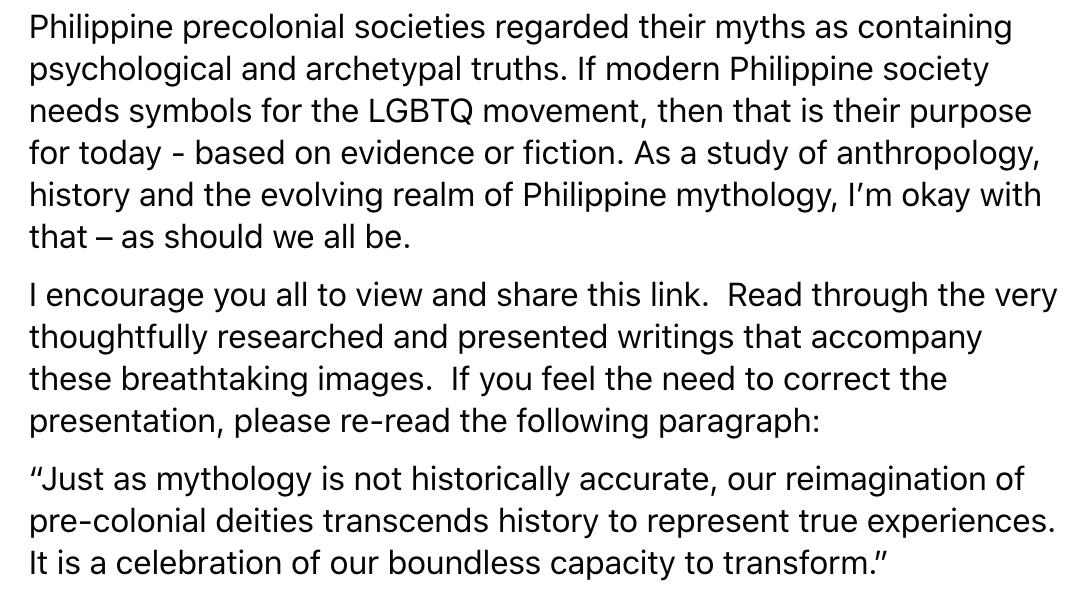
Our Own Work
It can feel like some of what we’re seeing is about a rift between Fil-Ams and Filipinos in the Philippines. I hear frustration from Fil-Ams that our American racial realities aren’t understood in the Philippines. I also hear stories from my Filipino friends in the Philippines, and see the online exchanges, where Fil-Ams talk right over Filipinos about issues there or tell them what to think, instead of listening, or making an effort to connect.
I don’t think us Fil-Ams realize something, and maybe it’s hard to admit. That American tendency to dominate? It lives in us too. We long to be understood by Filipinos in the motherland, but how much work have we put into understanding their perspectives? How familiar are we with the issues they’re facing? It must seem discouraging to Filipinos in the motherland that this controversy sucked up so much energy. We could be flexing our advocacy muscles for Covid vaccine access, climate change, or any number of other life-and-death issues, that would make a difference, that would build solidarity. That’s gotta be frustrating, on that side of the world, to watch all this. Do we Fil-Ams understand Philippine frameworks, and how they change across the regions and classes and languages? Are we even making an effort to listen, or have we already decided there’s nothing to learn?
Focusing on that rift, though, leaves out a third important group in understanding what happened: Filipino Canadians, the community that Jordan and his family are part of. I recently decompressed with a group of young Filipina Canadians, to ask what they felt about this controversy, and if they saw a difference between Fil-Canadians and Fil-Ams. At first, we talked about racial attitudes, the American racial melting pot versus Canadian multiculturalism as synonymous with tolerance. Then, reflecting on the whole event, one of them said, quietly, hitting the hidden core.
“We need a bigger discussion on trauma.”
She talked about how we’ve been under this layer of isolation for over a year now, on top of that deep hurt of losing one’s past through colonization, and more and more and more. For us Americans, we just witnessed a violent white supremacist mob get inches and minutes away from nullifying an election and murdering elected officials and we’ve just… moved on already? It hasn’t even been 5 months. Unprocessed trauma leaks out in the wrong places. I think this is actually the conversation we’re supposed to be having.
I wonder if borrowing another communities’ discussion might help us access our own emotions, if we could ask our Latina cousins for help on this one — Maria Hinojosa and Alexandria Ocasio-Cortez. I listened to their interview on Latino USA, and it hit deep. How relatable to this conversation we’re having now — on unprocessed trauma, identity, the deep pain of not knowing your own past. I strongly recommend a listen. This episode of Latino USA with AOC and Maria Hinojosa is here.
In Closing
I’d like to circle back to something — why Jordan does this project in the first place. Clearly, it’s a passion project (the way that Sari-Sari Storybooks is my passion project, a thing that’s created joy in my life). I am the daughter of a Filipina mom and white dad, and I felt ill reading those toxic assumptions about Jordan’s motivations and his family, as if there could only be something shady here. Like there’s something wrong with appreciating your partner’s culture? He could only be after money? He was acting like a sexpat? (Yes, that was an actual comment I read).
One reason is so obvious to me — he has a daughter. She’s Filipina. The work is also then, personal. His daughter is a Philippine mythology fan, a budding artist. It matters to Jordan, to know his daughter can grab any book she needs for a school project on Philippine spirits just by walking into his office. At her young age, she’s interested and knowledgeable enough to make her own animation of the Philippine creatures of lower mythology. I hate to think of her or any other young Filipino/a/x/s feeling afraid to make their own mythology work, as one twenty-something Filipina artist who messaged me privately said she was afraid to do now, because of this. That Filipina’s message is also why I wanted to write this open letter.
Lastly, I’d like to bring in the words of Jordan’s documentary production partner here, Cheryl Anne del Rosario. She’s known Jordan and his family for many years, and was there at the very beginning of The Aswang Project. I invited her to share something about Jordan. This is what she sent.
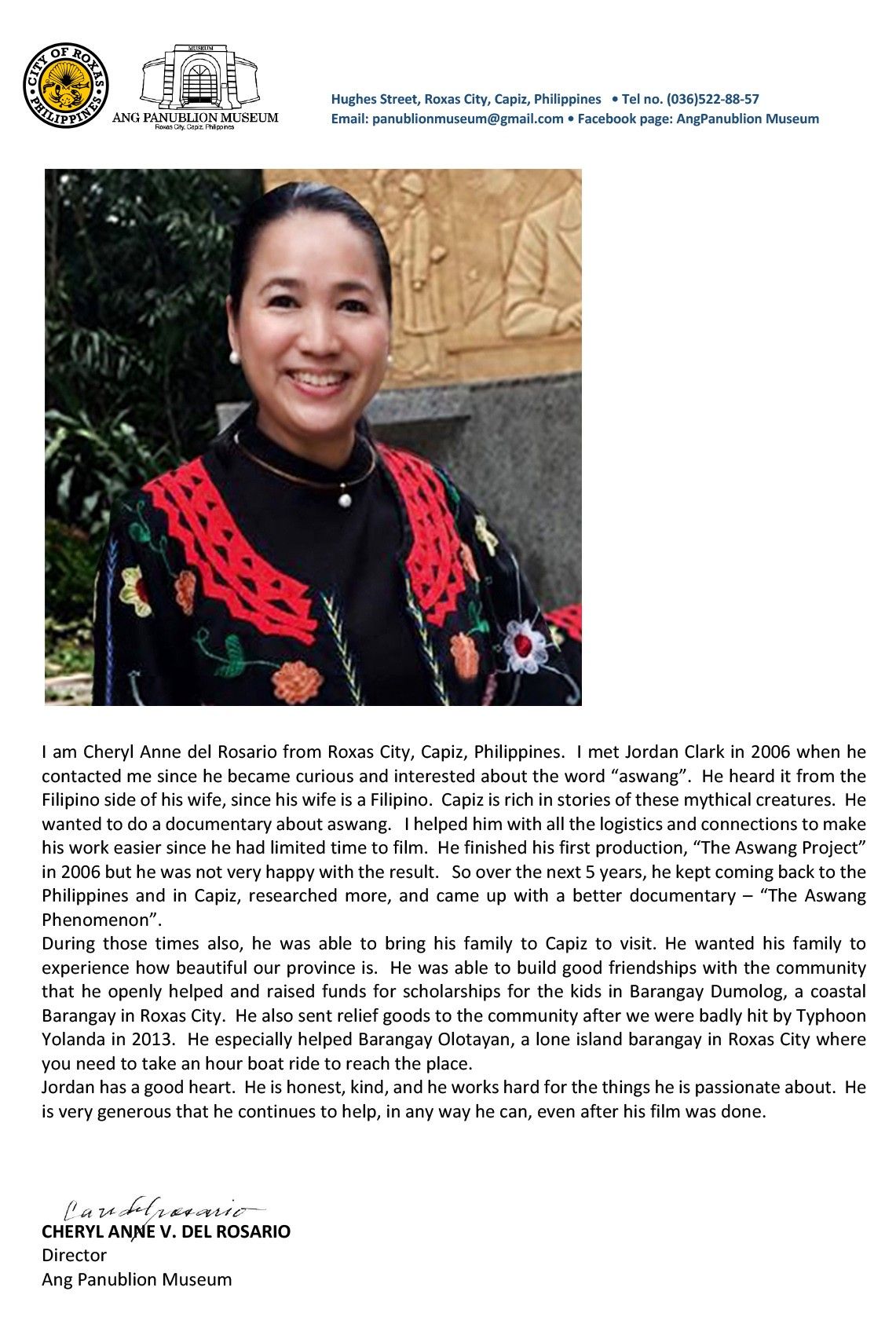
If anything, we can take all this as a sign of how hungry people are to connect to their roots, and how rich and fascinating Philippine mythology is. In that spirit, of reclaiming the positivity in the work, I’ll be following this open letter with profiles of Philippine mythology makers next week, and what they have to share about their work, sources, and things that go bump in the night.
Be kind to each other.
As published by the author in Medium. You can read the original article here. https://medium.com/@christina.b.newhard/open-letter-on-the-aswang-project-controversy-1465242b38d4
If you liked what you just read and want more of Our Brew, subscribe to get notified. Just enter your email below.

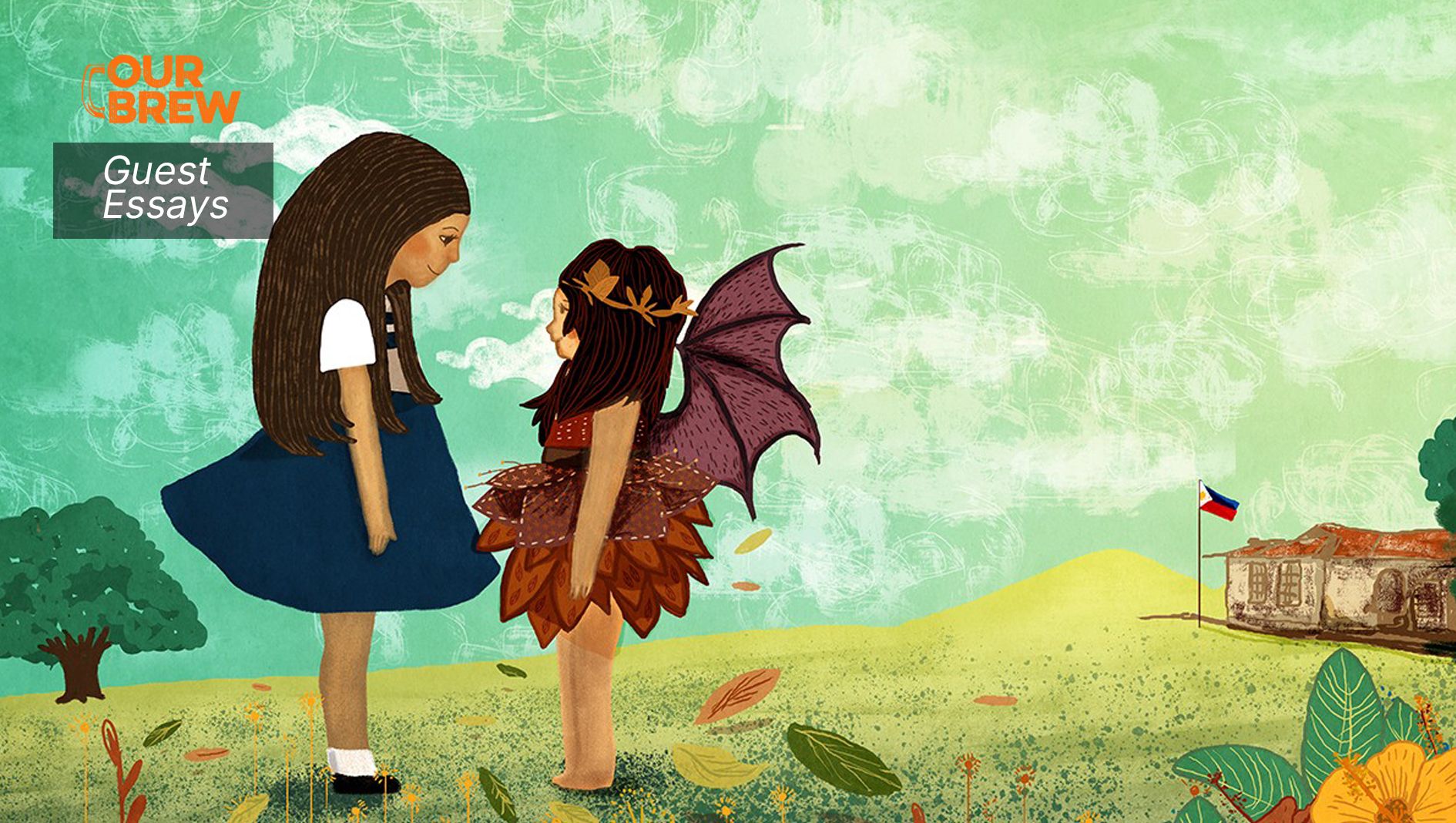
Related Posts
Welcome to the Algorithm Nation
Jun 10, 2024
A Lasting Bond in Fire and Steel
Apr 24, 2024
Art, Music and the Filipino Soul
Mar 01, 2024